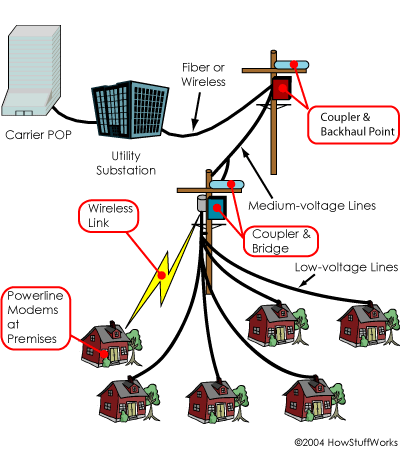Broadband Over Power lines (BPL) is the technology used to transmit data and provide internet access via electric power lines. The underlying mechanisms used for transmitting digital data over power lines have been around for a while and used by Electrical Energy Suppliers to monitor their power grids. As a matter of fact, many countries are now switching to Smart Grids (the American Recovery and Reinvestment Act signed by President Barrack Obama in February 2009 included $4.5 billion for Smart Grid development) to ensure electrical energy is distributed, monitored and managed more efficiently. What makes these Smart Grids smart is the ability to carry digital data across their extensive Power line networks and hook up with IT systems to process the data and manage the grid. The image below, courtesy of HowStuffWorks, illustrates broadband internet access over power lines (BPL).
Voice Over IP (VOIP) has revolutionized the telecom industry by integrating voice over data networks, thereby making way for the demise of the Public Switched Telephone Network (PSTN). Electrical grids have more reach than the copper telephone cables, thereby ensuring broadband access to the internet has a wider reach (e.g. in rural areas).
BPL and VOIP, both disruptive technologies, could bring about radical changes in the telecommunications and Electrical Power industries, with the prospect of pertaining all wired voice and data networks to power grids and in-house electrical wiring.
BPL does have its share of obstacles, power line noise interference and the use of frequency bands allocated to Amateur radio operators. However, the circulation of the first draft (for approval) of the IEEE Standard 1901 for BPL in July 2009, is a promising step towards full acceptance and standardization of BPL. And then, it will be only a matter of time before several electrical and electronic manufacturers develop a whole new range of BPL products (some BPL products are already out there).
Transmission of digital data along with electricity over power lines opens up a whole new world of possibilities. Imagine, if all your electrical appliances at home could exchange data with each other and with you. You could administer all your home appliances using software on your computer or handheld device. You could remotely turn on/off light switches in your home. You could schedule various tasks for all your appliances at home to automate your daily routine (alarm, lights, coffee, toast, etc.). Your world could become truly digital!
References:

